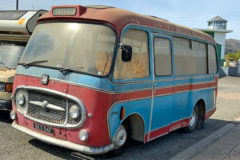P&O’s Far East Service ships
Posted by Chris Graham on 8th August 2021
Stephen Payne takes a nostalgic look back at the various ships that P&O operated on its once very popular Far East Service.
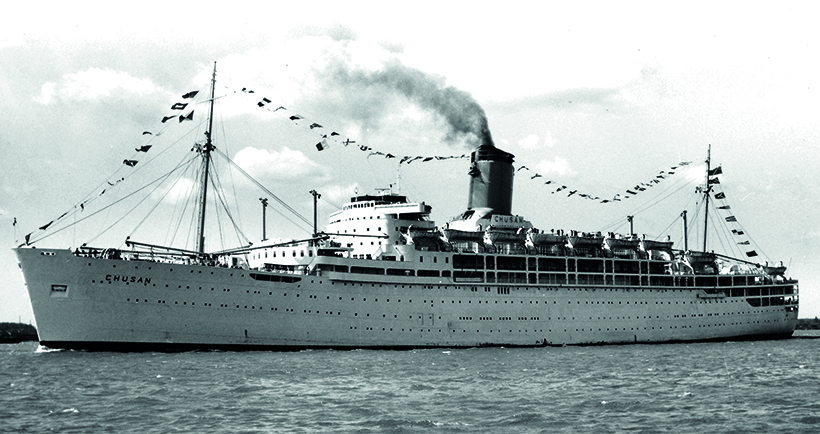
Chusan was completed in 1950 by Vickers at Barrow for P&O’s Far East Service. She was by far the largest and most luxurious ship on the run, and operated with Carthage, Corfu and Canton until the early 1960s, when Cathay and Chitral took over the route.
Apart from the Peninsular & Oriental Steam Navigation Company’s (P&O) frontline express service to Australia, several other secondary – but no less important – routes were operated by the company, including the so-called slow-steaming ‘Branch Line Service’ between London and Australia via Cape Town, catering for Third and Steerage classes, as well as a dedicated service to India and the Far East Service.
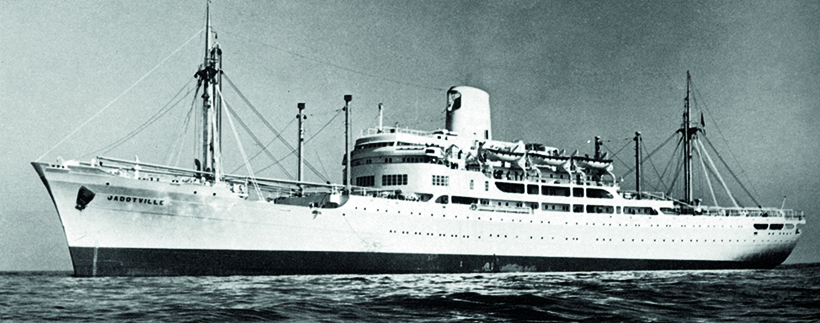
In the early 1960s, after only four years of service, the Belgian liners Jadotville and Baudouinville were purchased and entered P&O’s Far East Service, as Chitral and Cathay.
The latter operated out of London, and ran to Port Said, Aden, Bombay, Colombo, Penang, Singapore, Hong Kong, Shanghai, Kobe and Yokohama. Up to the late 1920s, the Far East Service was operated by six, 9,000gt steamers, which had entered service in 1914-15 and were capable of 14 knots, carrying about 80 First and 68 Second class passengers. They were coal-fired, reciprocating steam-driven vessels which, by the late 1920s, were totally outmoded. So, in 1929, P&O elected to build two new, 14,000gt replacements.

Carthage and her fleetmates on the Far East route had extensive cargo holds, as indicated by the number of cargo derricks.
The general arrangement of the new ships was based on the successful Cathay/Comorin/Chitral vessels of 1925, but with single-reduction steam turbine machinery of 15,500shp, instead of the reciprocating machinery, which raised their speed from 17 to 18 knots. Originally to be named Cheefoo and Canton, the ships were ordered from Alexander Stephen & Sons on the Clyde. Before their launch, however, the ships’ names were changed to Corfu and Carthage; the former began her maiden voyage on October 16th, 1931, and her sistership followed in early December, 1931.
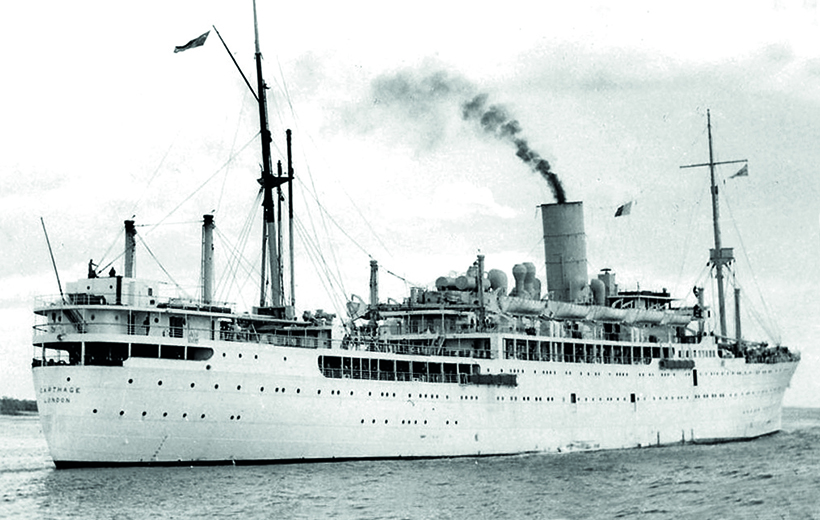
Carthage was a sistership to Corfu and, when introduced in the early 1930s, the pair provided greatly upgraded facilities on the Far East route.
In October 1938, Corfu and Carthage were joined by Canton; a somewhat larger and improved ship that was also built by Alexander Stephen & Sons in Linthouse, Glasgow, at a cost of £820,000. This 15,748grt ship had an additional passenger cabin deck and was 44ft longer and 2ft wider. Facilities included a single lift in First Class and a single, open-air swimming pool aft of the First Class public rooms on B Deck. The First Class Dance Space doubled as a cinema, and the ship is noted for being the first P&O vessel to employ a ‘cinema operator’.
Canton was a beautifully-proportioned ship with a single funnel, and was delivered in P&O’s black livery. She was particularly well appointed, with fine wood veneers throughout her public rooms, giving a refined, gracious ambiance. For a full history of Canton, refer to the April 2018 edition of Ships Monthly.
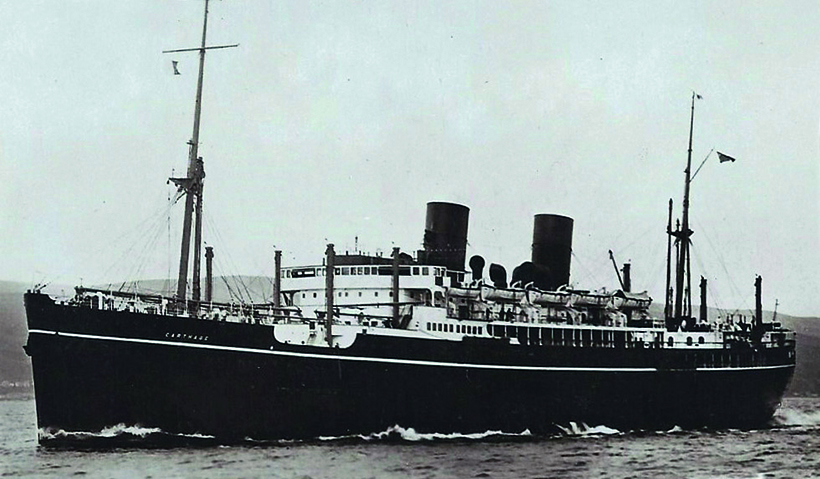
Carthage in her pre-war, black-hull livery, with a second dummy funnel aft.
Like many passenger liners, the Far East Service ships were kept busy throughout World War II. Canton was initially refitted as an armed merchant cruiser with eight, six-inch and two, three-inch guns. On January 9th, 1940, she ran aground on rocks off Barra Head, in the Outer Hebrides, and was badly damaged. Fortunately, she was freed two days later, but required extensive repairs before returning to service.
After numerous patrols in the Western Approaches and East Indies, she was converted into a troopship at Cape Town in May 1944. Meanwhile, Carthage was similarly taken in hand and armed, serving in the Indian Ocean as a convoy escort vessel. In 1943, she was converted into a troopship and operated out of Calcutta.
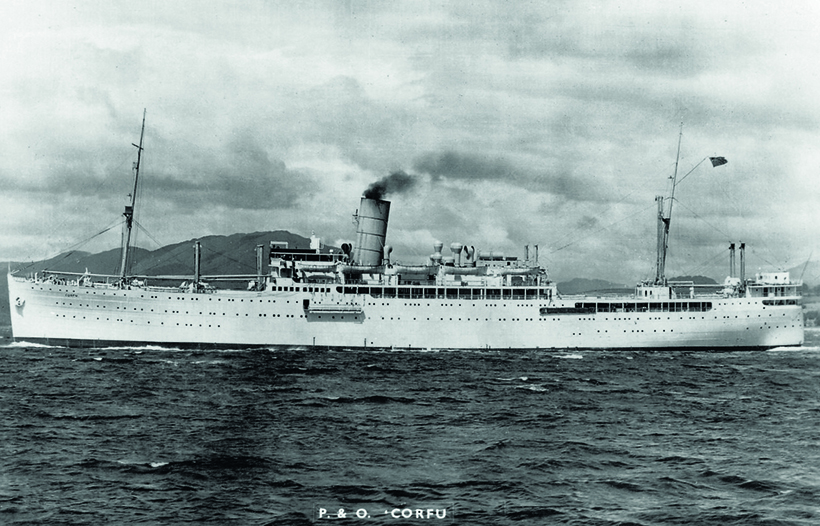
Before World War II, Corfu had a black hull and a second dummy funnel. However, after the war, the ship was given the company’s new, white livery.
Corfu was still in government service after the war, when she was used to repatriate former Japanese-held British prisoners of war to Southampton. In early April, 1946, she was due to sail to India with 1,205 British troops, but 450 walked off, citing poor conditions on board. She later sailed with 100 of the deserters who had returned to the ship.
In October 1947, Canton reopened the Far East Service and, by January 1949, all three ships had been reconditioned and were back in service. Corfu and Carthage emerged without their dummy funnels reinstated, and the original forward funnel raised in height. They also appeared in P&O’s white Strath livery of white hull and superstructure, with buff-coloured funnel.
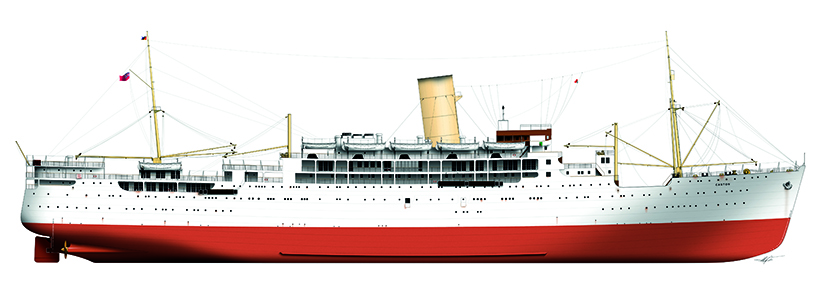
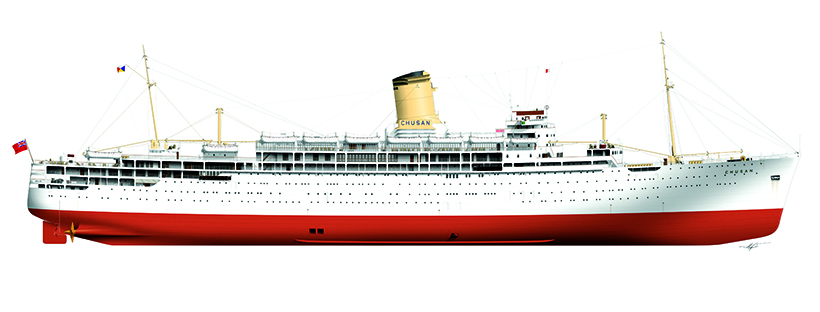
The two largest liners to serve P&O’s Far East Service were Canton (1938) and Chusan (1950). The top graphic shows Canton as she appeared post-war, with P&O’s white livery displacing her original black-hull livery. The bottom illustration depicts Chusan as she appeared while she was engaged in P&O’s Far East Service, before full air-conditioning was installed. (By courtesy of Michael Brady-LinerDesigns)
While Canton also adopted the white livery, her passenger accommodation was extended by erecting a further 14 passenger cabins at the forward end of C Deck, which raised her gross tonnage to 16,033. Initially, the Far East Service from London extended only as far as Hong Kong, as Japan was seen as undesirable so soon after the war.
In June 1950, P&O took delivery of their second post-war newbuilding, the 24,215grt Chusan, which was specially built by Vickers Armstrongs at Barrow, to augment the Far East Service. She was by far the most luxurious and fastest of the ships on the route, and was very similar in concept to the latter, pre-war Straths.

The First Class Lounge on board Canton was extremely elegant and comfortable.
Chusan was the first passenger liner to be built with Denny Brown stabilisers, which had proved reliable on cross-Channel ferries. The decision to install these was made just two months before Chusan’s launch. The stabilisers significantly reduced rolling, and led to Arcadia and Iberia being contracted to receive them, while Himalaya had to wait until 1959 to be retrofitted with hers.
The Far East Service catered for a diverse clientele, ranging from civil servants and administrators to business executives, including rubber barons, plantation owners and merchants in First Class. Local migrants and tourists tended to occupy Second Class, and cargo space was frequently block-booked for the import of Asian textiles and plastic products manufactured in Hong Kong.
Woolworths often booked space to import products sourced from Asia, cheap novelties and toys being regular items on the manifest. Outbound, UK-manufactured products and crated cars were exported by the ships. In December 1953, Canton brought home to the United Kingdom three, Royal Navy Rear Admirals from the Far East, after they’d relinquished their naval commands.
The four ships maintained the service, sailing through the Mediterranean, until November 1956, when the Suez Canal was closed and the routing had to be temporarily changed to sail around Africa, via Cape Town.
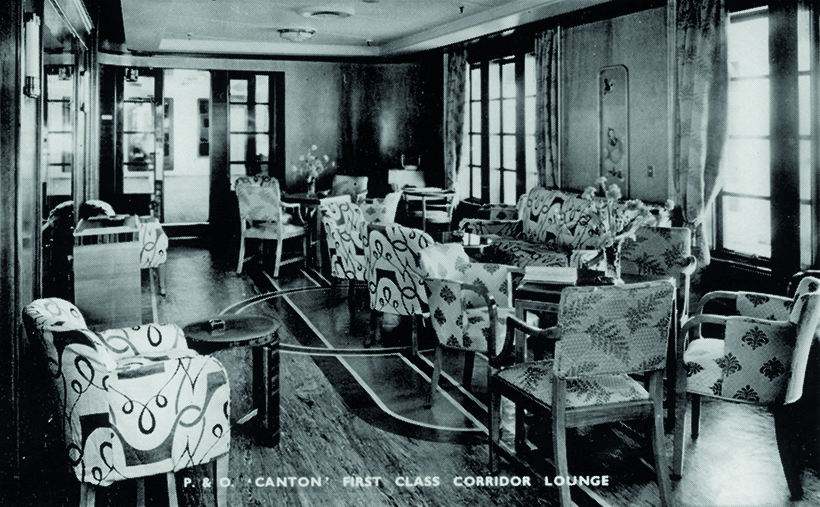
Canton’s First Class Corridor Lounge connected the Main Lounge and the Dancing Space.
While berthed in the King George V Dock at Tilbury, Canton suffered a fire on October 15th, 1957, when her cargo of toilet paper caught fire, requiring assistance from the local fire brigade to put it out. Luckily, the damage wasn’t extensive and, after unloading her damaged cargo and being repaired, she was able to start her delayed voyage.
While Chusan was despatched to Harland & Wolff in Belfast in late 1959, for an extended refit and upgrade to receive full air-conditioning, the three pre-war ships were left unaltered. Carryings of both passengers and cargo were beginning to drop off on the Far East route, and it was clear that the existing service wouldn’t be sustainable for much longer. Costs were also rising, and this was hampered by the necessity for a two-week turnaround between voyages, for unloading and loading cargoes.
In January 1961, two relatively new, partially air-conditioned passenger-cargo liners, Jadotville and Baudouinville of Compagnie Maritime Belge, came on the market, when their route between Antwerp and Matadi was withdrawn. P&O seized the opportunity to acquire the two 14,000grt ships, which had been built less than five years earlier. Following short refits, in which their passenger accommodation was modified to carry 235 First Class passengers, the ships entered service as Chitral and Cathay in February and April 1961 respectively, hastily replacing Corfu and Carthage, which were sold to Japanese breakers
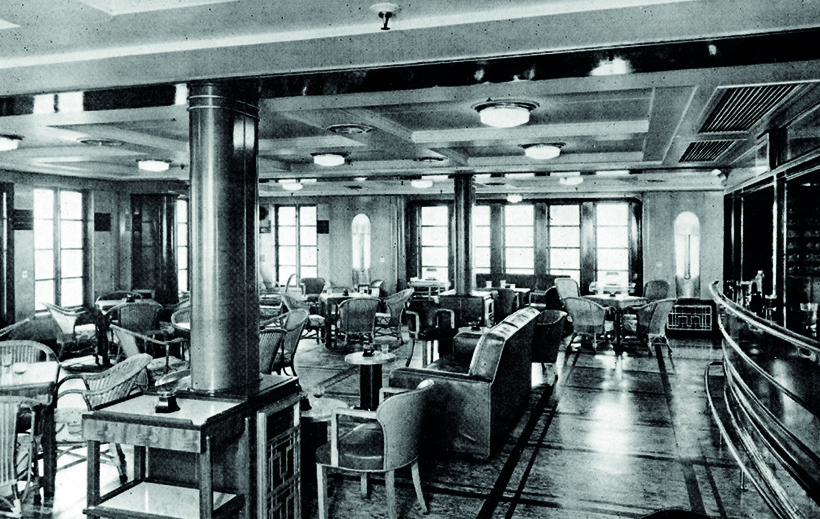
Canton’s First Class veranda had windows on three sides, and was a fine refuge for refreshments in the tropical heat.
The ships were provided with a lounge, a writing room, smoking room with bar, and a veranda café. The restaurants were large enough to offer single-sitting dining, and other facilities included a cinema, children’s playroom, shop, hairdressing salon, and an open-air swimming pool. Many of the cabins had private facilities, and the restaurant, lounge, cinema, hair-dressing saloon and some cabins, were air-conditioned.
With the introduction of these two ships, the Far East Service was reinstated to pre-war status as far as Japan, with calls at Kobe and Yokohama. The ships would load cargo at the King George V in Tilbury then sail to Southampton, where passengers would embark before the ships would begin their round-trip voyage, which would last 10 weeks. The Sultan of Selangor was a frequent passenger, sailing between Singapore and Hong Kong, together with his aides, on shopping trips.
Sadly, after only 24 years of service, seven of which were spent on war service, the elegant Canton was withdrawn from service on August 28th, 1962, and sold for scrap in Hong Kong. The following year, further rationalisation occurred when Chusan was removed from the Far East Service and rerouted to join other members of the P&O passenger fleet on the Australian run.
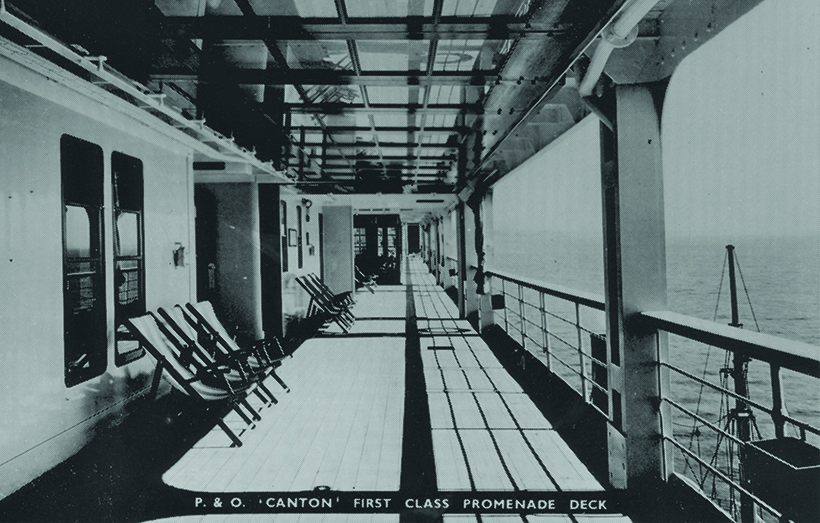
The First Class external promenade on board Canton could be partially enclosed using the overhead screens.
Thereafter, only Chitral and Cathay maintained the service until early 1970, when the service ended. Chitral was used as a cruise ship between March and September that year, but her large cargo capacity and low passenger density was a handicap to profitable operation. P&O considered rebuilding both ships as cruise ships, by adding further accommodation to their cargo holds but, in the event, both were transferred to the P&O subsidiary Eastern and Australian Steam Ship Company, and sailed between the Far East and Australia.
In 1975, this service ended and Chitral was sold for breaking, while Cathay was sold for further service with Chinese owners, surviving until 1996. Meanwhile, Chusan, always referred to as the ‘Happy Ship’, was increasingly deployed as a cruise ship after leaving the Far East Service with only intermittent line voyages. She was extremely popular in this capacity, but the sharp rise in fuel prices in the early 1970s, coupled with her rather limited passenger numbers, led her to be finally sold for scrap in Taiwan in May, 1973.
For the record, the last sailing of the Far East Service was undertaken by Chitral in January, 1970, which brought an end to P&O’s 134-year-old Far East Service.
For a money-saving subscription to Ships Monthly magazine, simply click here



